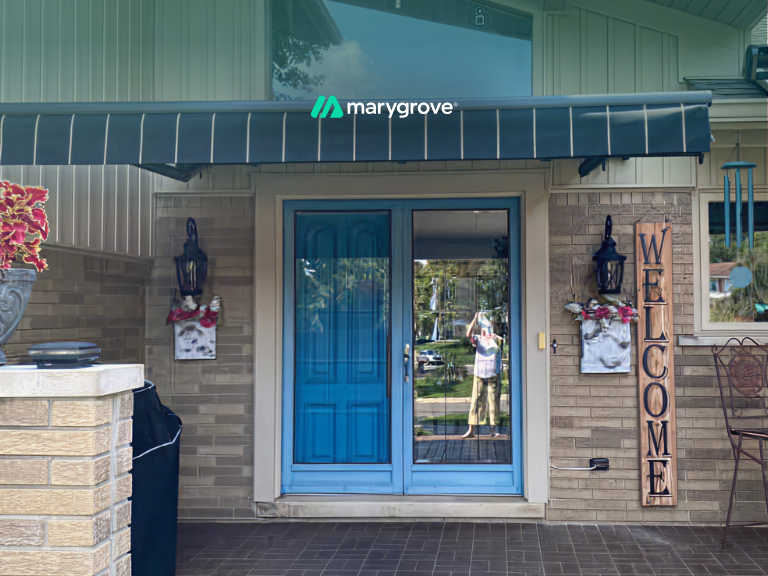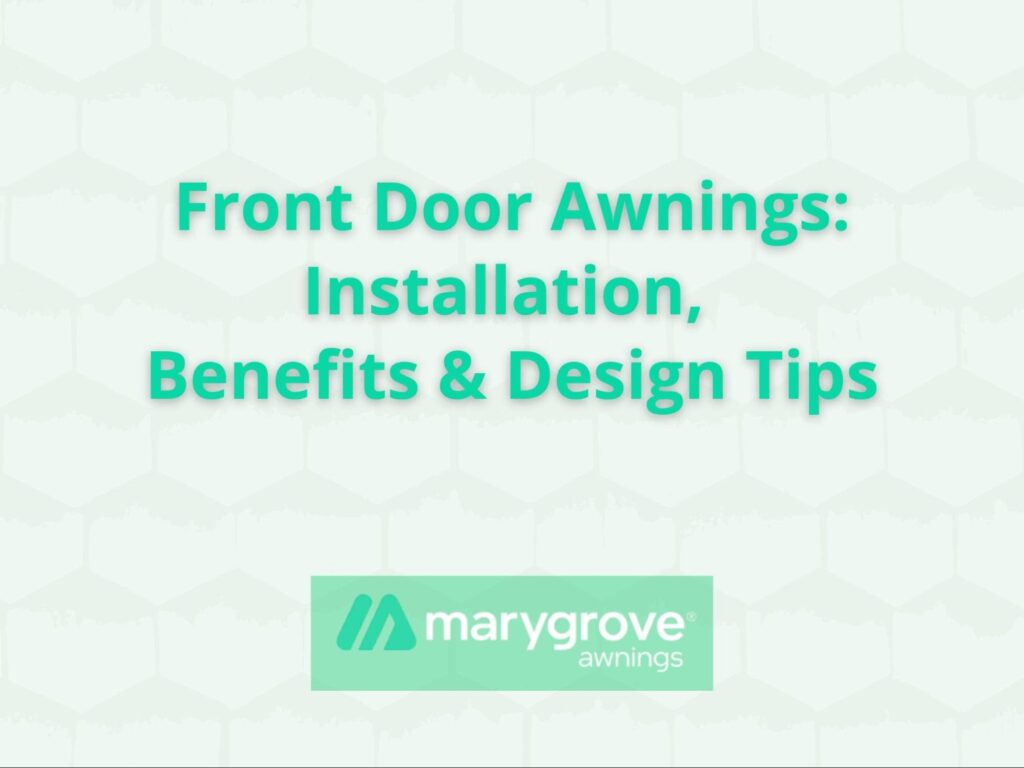A front-door awning can be installed on almost any home, offering shade, weather protection, and instant curb appeal. When installed correctly, it prevents water damage, improves energy efficiency, and enhances your home’s design.
Key Highlights:
- Mount directly into studs with proper flashing for durability.
- Choose angled frames to handle wind, snow, and rain effectively.
- Most areas require no permits, but confirm HOA or local rules.
- Match materials and colors to your architecture for a cohesive look.
- Add smart retractable features or lighting for both style and safety.
This small addition protects your home’s entryway, keeps your door looking new, and adds long-term value without a large investment.
A thoughtfully designed awning doesn’t just cover your front door, it transforms your home’s entire exterior harmony.
Here’s how to make the most of it.
What to Know Before Adding an Awning Over Your Front Door

Installing an awning above your front door can add both charm and protection, but it’s not as simple as screwing brackets into the wall.
Before getting started, it’s important to understand structure, weather exposure, local rules, and a few smart prep steps to avoid issues later.
1. Mounting and Structure
Most front-door awnings are wall-mounted rather than freestanding. The brackets must anchor securely into studs, not just siding, for lasting support.
Flashing, thin metal sealing at the wall joint, is essential to stop rain from seeping behind the mount. Skipping this step often leads to water damage and mold.
A properly secured wall-mounted awning looks seamless and feels permanent.
2. Weather and Exposure
Front doors face higher wind pressure than patio spaces.
If you live in a windy or snowy area, look for aluminum or steel frames with a sloped or adjustable pitch to shed snow and rain.
Avoid flat designs that trap water. Planning for your local weather ensures year-round protection and stability.
3. Rules and Codes
Most small awnings fall under “no permit required,” but it’s always smart to double-check with your local building department or HOA.
Regulations can vary by neighborhood, especially if your home faces the street or sits in a historic district.
Here are a few common limits to watch for:
- Projection: Usually must not extend more than 3 feet from the wall
- Height: Often limited to 10 feet or less from ground level
- Placement: Should be at least 2 feet from sidewalks or property lines
- Color and Material: Some HOAs require neutral tones or materials that match your home’s design
- Historic Zones: Homes in heritage or conservation areas may need design approval before installation
Knowing these details early helps you avoid delays and costly revisions.
Once you confirm the rules, you can confidently move on to design and installation knowing your project is compliant and ready to go.
4. Final Prep
Measure carefully, inspect the wall surface, and plan for water drainage before choosing materials. When properly installed, a front-door awning adds lasting value, blending shade, shelter, and style.
With the groundwork set, you’re ready to explore why this small upgrade makes a big difference for both comfort and curb appeal.
Helpful Resource → How to Install a Retractable Awning on Stucco Walls
Why a Front Door Awning Is One of the Smartest Home Upgrades You Can Make

A front-door awning does far more than add a bit of shade.
It’s one of those small exterior upgrades that quietly transforms daily life, keeping your doorway dry, reducing energy costs, and giving your home a polished, welcoming look.
Below are the key reasons homeowners and designers alike consider it a smart investment.
1. Protection from the Elements
Rain, snow, and direct sun are tough on entryways.
A well-designed awning shields the door, hardware, and threshold from moisture, preventing warping, rust, and paint damage.
It also stops UV rays from bleaching finishes or heating up the space right inside the door.
2. Energy Efficiency and Longevity
By shading one of the most heat-prone areas of your home, an awning helps lower indoor temperatures and reduces strain on your air conditioning, especially for south-facing doors.
This also extends the life of nearby flooring and furniture by protecting them from fading or cracking due to sunlight.
3. Curb Appeal and Everyday Function
Visually, an awning adds structure and symmetry, framing the front door like a natural architectural feature.
It brings depth and character to a flat façade, creating a welcoming focal point that instantly enhances curb appeal.
Functionally, it keeps the entry area clean, limiting puddles, mud, and slippery steps that guests and family might otherwise track in.
4. Smart Comfort and Low Maintenance
Modern awnings combine durable materials with technology.
Aluminum or acrylic models resist rust and fading, while retractable designs allow you to adjust shade as needed.
Advanced systems even include voice or app control and wind sensors that automatically retract the canopy in harsh weather, adding both convenience and peace of mind.
Next, let’s explore a few simple design choices that make a front-door awning look truly stunning.
Helpful Resource → How Far Can a Retractable Awning Extend?
Small Design Choices That Make a Front Door Awning Look Stunning

The beauty of a front-door awning lies in its details.
With the right design choices, it becomes an architectural highlight instead of just a shade fixture. Use these simple, style-focused ideas to turn practicality into curb appeal.
- Match the Architecture: Pair sleek aluminum or steel awnings with modern homes, and use wood or GRP for traditional or craftsman-style façades.
- Coordinate the Color Palette: Match your awning’s frame or fabric with existing trim, shutters, or door color for a cohesive, high-end look.
- Light the Way: Install recessed downlights or small sconces beneath the canopy for warmth and visibility, especially if existing fixtures were displaced.
- Frame for Balance: Extend the awning 6–12 inches beyond the door frame to create symmetry and full coverage from rain.
- Add Side Screens for Comfort: Slim privacy or solar screens turn a front step into a cozy, shaded landing space.
- Hide Bracket Clutter: Clean mounting lines maintain a seamless appearance and prevent hardware from drawing attention away from your awning’s design.
- Blend Form and Function: Choose minimalist lines for contemporary homes or curved valances for a soft, classic charm.
- Go Smart and Sleek: Consider full-cassette retractable systems with LED strips or motion sensors for both beauty and convenience.
A well-designed front-door awning sets the tone for your home’s entire aesthetic, but its real magic appears when the same design language flows across your exterior.
The next step is extending that harmony, tying every entrance, window, and outdoor space together for a truly unified look.
Complementary Spots That Tie the Whole Exterior Together
The Dugan’s Customer Testimonial
A front-door awning looks best when it feels like part of a complete design story. Extending that same visual rhythm to other areas of your home creates a cohesive, well-balanced exterior.
Here’s how to make it all connect beautifully.
- Windows for Balance: Add matching mini-awnings above front windows to frame the façade, improve symmetry, and block midday heat for better energy efficiency.
- Side Doors and Garages: Install smaller versions above secondary entrances or garage side doors for design consistency and year-round weather protection.
- Patios and Decks: Carry the same color or frame finish to the backyard with retractable awnings that tie the front and back of your home together.
- Porches and Walkways: Covered pathways or small awnings between structures add a welcoming, high-end touch while keeping you dry as you move between spaces.
- Outdoor Seating Areas: Pair the style of your front-door awning with retractable pergolas or privacy screens to create a seamless outdoor entertainment flow.
- Second-Story Windows: Use slim drop-arm or cassette awnings upstairs to add vertical balance and protect upper rooms from glare and heat.
- Smart Home Integration: Connect all awnings through a single weather-responsive system for effortless, synchronized operation across your entire home.
Coordinating awnings across key exterior spaces turns your house into a unified, visually polished home that feels intentional from every angle.
Bringing It All Together: A Unified, Weather-Proof Home
Adding an awning over your front door isn’t just about keeping dry, it’s about elevating the entire look and feel of your home.
When coordinated with windows, walkways, and patios, it creates flow, balance, and architectural charm that lasts for decades.
With thoughtful design and proper installation, a front-door awning blends form, function, and long-term value.

Whether you want a traditional accent or a smart retractable system, the right choice enhances both comfort and curb appeal.
Ready to protect your home and enhance its look?
Schedule your Marygrove Awning installation today and experience unmatched quality, design consistency, and value built to last.

